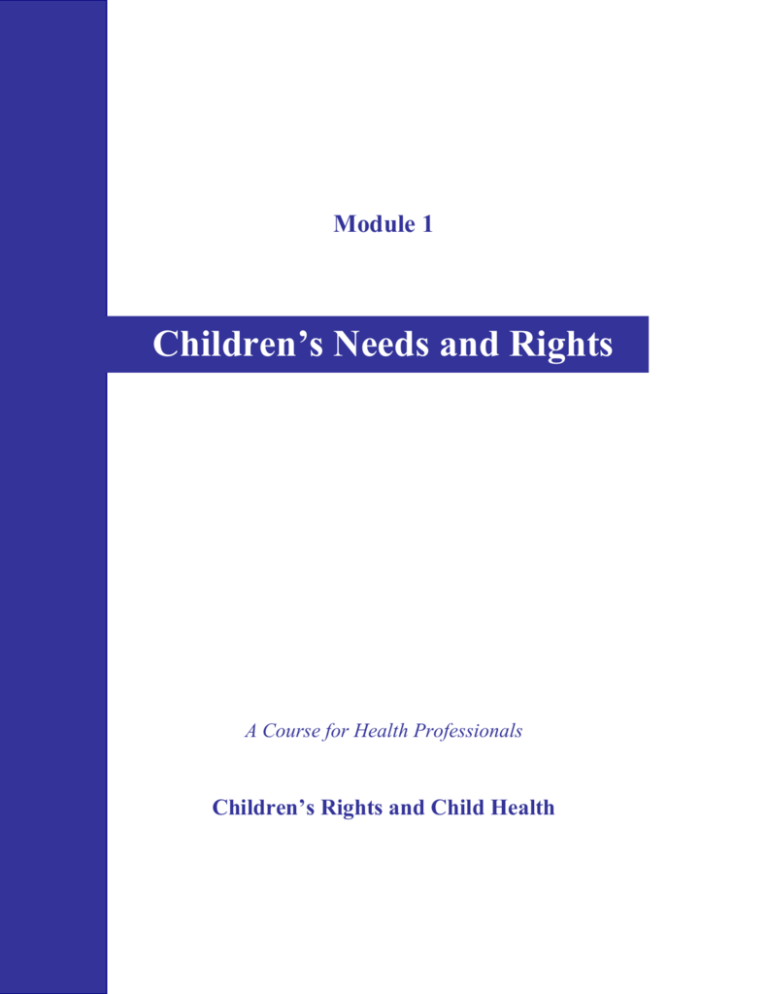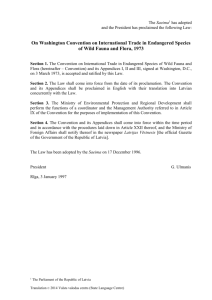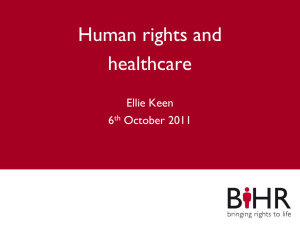Module 1
advertisement

Module 1 Children’s Needs and Rights A Course for Health Professionals Children’s Rights and Child Health Children’s Needs and Rights Learning Objectives for Module 1 1. Understand the definition of universal needs of children 2. Understand the relationship between children’s needs and children’s rights 3. Explain how children’s requirements for adult support and assistance in meeting children’s needs creates an entitlement or right to have their needs met by adults 4. Understand the special role of child health providers in ensuring respect for children’s rights Content of Module 1 The aims, rationale and structure of the course are presented in Table 1. Module 1 explores the basis of children’s rights in children’s humanness, the relationship between children’s needs and rights, and addresses the reasons why children’s rights are important. Our goal for this Module is to explore the needs that children have at each stage of their lives, whether children in all societies have needs in common, and which needs differentiate children from adults. These needs form the basis for defining standards that should be recognized as necessary for optimal health and development of all children in all societies. If all children have certain needs in common, then it follows that the adult world has obligations to meet them. Children are entitled to have their needs met in order that they can fulfill their optimum potential. In other words, they have rights. Table 1 Introduction to Needs and Rights Aims of the course: To raise awareness of the Convention on the Rights of the Child To increase understanding of the application of the rights articulated in the Convention to health policy and practice To promote insight into how policy and practice can be improved to effect greater respect for the rights defined in the Convention To raise awareness of the relationship between public policy and the health rights of children To encourage a commitment to the development of an advocacy role in respect of children’s rights 1- 1 Rationale of the course: All children have needs. The Convention on the Rights of the Child establishes international recognition that children have a right to have these needs met. The Convention provides a comprehensive framework of rights that will facilitate a holistic approach to promoting the well being of children. Children’s health and development is best promoted by the fulfillment of all their needs. Respect for all the rights embodied in the Convention will help achieve this goal. The Convention is legally binding and imposes obligations on governments to respect children’s rights. Structure of the course: Module 1: Module 2: Module 3: Module 4: Module 5: Children’s Needs and Rights Highlights of the UN Convention on the Rights of the Child Respecting Children’s Rights in Pediatric Practice Health Policy and Health Services The Health Professional as Advocate Activities and Discussion The following two Activities are meant to help you develop an understanding of the “universal needs of children,” and their relationship to children’s rights. The material that follows each of the activities will encourage you to think about ideas that are different from the way you have previously conceptualized children’s needs. Activity 1.1 Activity 1.1 focuses on the development of an understanding of the prerequisite needs of children to ensure their optimal health and well being. 1- 2 Activity 1.1 Create a List of Children’s Needs For each of the three broad domains below identify what a child needs in order to fulfill his or her full potential for health and well-being: 1. Physical needs 2. Social and Cultural needs 3. Intellectual, Psychological and Emotional needs How would you define lower and upper age limits of childhood as they relate to the children’s needs you identified? Approach this task in general terms. It is not necessary to define the exact detail of the needs that you are describing. Discussion Children’s needs define the prerequisites for their optimal growth, development, health and well being. The following Table provides a suggested framework for considering and categorizing children’s needs. Table 2 A Framework of Children’s Needs Physical needs Shelter Health care Water and sanitation Protection from environmental pollution Adequate food Adequate clothing Protection from violence Social, Economic and Cultural needs Knowledge of and respect for own language, religion and culture Stable social and economic environment A family environment – whether the biological or a substitute family Access to appropriate guidance and support Access to age appropriate information Respect for privacy and confidentiality Access to education 1- 3 Intellectual, Psychological and Emotional needs Opportunities for play Access to education Access to age appropriate information Stimulation Access to appropriate guidance and support Respect for privacy and confidentiality Recognition of and respect for emerging competencies Protection from exploitation and abuse Opportunities for friendship Opportunities for play Opportunities to be listened to and respected A family environment, whether the biological or a substitute family Activity 1.2 Activity 1.2 moves the discussion from listing and categorizing needs (rights) to develop an understanding of the characteristics of these needs (rights). Activity 1.2 Discuss the Characteristics of Children’s Needs Respond to these questions, as you consider the needs of children in your practice, your community, nation and the world. 1. Which needs apply to all aspects of a child’s development? 2. What inter-relationships and inter-dependencies exist between needs and rights? 3. How do children’s needs (rights) change at different stages of their development? Are there age-specific vulnerabilities? 4. Do these needs extend to all children in all societies, irrespective of the a country’s wealth or stage of development? 5. Who is responsible for meeting children’s needs? Discussion The following responses to the questions posed in Activity 1.2 may stimulate further thinking and/or discussion related to the characteristics of children’s needs. 1. Which needs apply to all aspects of a child’s development? Shelter is a physical need, but it does not fulfil intellectual or emotional needs, whereas education is needed for fulfilment of social and cultural needs, AND for the satisfaction of intellectual, psychological and emotional needs. Is there a set of fundamental needs that are essential for the well being of children, as differentiated from more “trivial” needs of children? 1- 4 2. What inter-relationships and inter-dependencies exist among needs? A child’s need for health care will be influenced by whether or not s/he has access to an adequate standard of living. A child’s mental health and well-being will be influenced by access to a secure family life; by understanding and respect for his or her identity and culture; and experience with being listened to and taken seriously, as well as by access to appropriate mental health services. 3. How do the needs of children change through their various stages of development? Privacy and respect for confidentiality are issues that are of increasing concern for older children, as is respect for their increased capacity for decision-making. However, physical needs endure throughout childhood, as do needs for protection from violence and discrimination. 4. Do these needs extend to children in all societies, irrespective of wealth or stages of development? These needs are universal to the health and well being of all children, whether or not they are all currently being met in the US, UK and in other developed countries, as well as in developing countries around the world. 5. Who is responsible for meeting children’s needs? Parents? Other adult individuals? Organizations? Governments? Health care providers? Pediatricians? 6. Should we invoke children’s needs when focusing on children’s rights? Rights are considered to be a higher “order” principle than needs, and universally due to all people based on our common humanness. As such, they cannot be discriminated against and cannot be revoked. It could be construed that the obligation to meet a child’s “needs” is not as great as the obligation to fulfill their rights. While this might be true, the concept of “needs” provides a context and framework for those not familiar with children’s rights to begin to understand the meaning of “rights” and the relevance and importance of the Convention. Conclusion The needs and rights of children form the basis for a universal set of standards by which all children should be treated in order for them to achieve their full potential for health and development. If there is universal acceptance that common minimum standards apply to the treatment of all children, it follows that children are entitled to 1- 5 have these needs met. In other words they have rights, and adults are obliged to ensure that children’s rights are respected. In summary: All children have rights that emanate from their humanity. In addition, all children have basic universal needs. These needs form a basic set of common standards necessary for optimal health and development. Children are entitled to be treated according to these common standards. These standards impose obligations on adults to ensure their fulfillment. A commitment to fulfilling these obligations creates rights for children to have their needs met. These rights have been codified into an international human rights treaty, the UN Convention on the Rights of the Child, which introduces universally binding obligations on governments to protect and promote the rights of children necessary to fulfill their needs. 1- 6 Additional Reading As presented in Table 1, A Framework of Children’s Needs, all children have needs that can be grouped into three broad categories – physical needs; social, economic and cultural needs; and intellectual, psychological and emotional needs. Physical needs: shelter, health care, water and sanitation, protection from environmental pollution, adequate food, adequate clothing, and protection from violence, exploitation and abuse Social, economic and cultural needs: knowledge of and respect for own language, religion and culture, stable social and economic environment, recognition of and respect for emerging competencies, access to appropriate guidance and support, access to play and friendships, respect for privacy, and freedom from discrimination and prejudice Intellectual, psychological and emotional needs: a stable and loving family environment, access to education, age appropriate information, stimulation, and opportunities to be listened to and taken seriously. The relationships among needs and rights The consequences below follow from an understanding of children’s needs. Children’s needs are universal. They apply to children in all socio-economic and cultural environments. It does not matter whether a child lives in sub-Saharan Africa, Tajikstan or Sweden, he or she has needs for a stable family life, adequate food, education, and respect for his or her abilities. The way in which needs are met will vary in different cultures and for different children. For example, family structures differ, children start education at different ages, opportunities for play may be more or less formal, the relationship of children to work varies, disabled children may need additional support, etc., but their fulfillment remains necessary for their optimal health and well being. The fulfillment of all needs is essential for children’s optimal health and development. There is often a tendency to view physical needs as having priority. Clearly at one level, it is true that without food, children will die. However, it is also true that without education or play, children’s potential cannot be realized. And, without respect and freedom from discrimination, their psychological and emotional well being will be impaired. Children’s needs are mutually inter-dependent, none take precedence over another. Children cannot fulfill their needs without adult support. Their youth, vulnerability and lack of power mean that they are dependent on the adult world to ensure that their needs are met. This places obligations on adults to create the necessary conditions that will ensure this happens. This obligation extends not only to the fulfillment of needs for individual children, such as family life, access to health care or education, but also the consideration of public policies that potentially impact on children’s health and development – housing, transport, environment, macroeconomics and poverty. This 1- 7 means that government policy at all levels must take active and consistent account of children’s needs. Acceptance of the premise that adults have responsibilities or obligations to meet children’s needs is de facto acceptance that children are entitled to have their needs met. In other words, children have rights. These rights have been endorsed and codified by the international community in the UN Convention on the Rights of the Child. The Convention elaborates these rights and calls on governments to introduce the necessary measures to ensure that these rights are respected for all children. It asserts that: a) they are universal, indivisible and inter-dependent, and b) their fulfillment must be grounded in a commitment to an understanding that children, as subjects of rights, must be respected, listened to and taken seriously in the exercise of their rights. In summary, the following premises underlie the UN Convention on Rights of the Child and this course: All children have rights that emanate from their humanity. In addition, all children have needs (rights), the fulfillment of which will facilitate their health and development. Needs (rights) extend beyond the physical to encompass social, economic, cultural, intellectual, emotional and psychological needs. Children cannot fulfill those needs (rights) without adult support. These needs (rights) can only be fulfilled if adults accept responsibility for meeting them. Children are entitled to have their needs (rights) met/fulfilled. Because children have rights, adults have a responsibility to protect and fulfill them. Recognition that children have rights with respect to all their needs, demands an approach in which children become active participants in the decisions and actions that affect them, not merely recipients of adult intervention and protection. Child health providers (pediatricians) and other professionals engaged in the fulfillment of children’s needs have a special obligation and opportunity to ensure that children’s rights are met. 1- 8 Optional Handouts Module One Children’s Needs and Rights 1- 9 HANDOUT 1.1 Introduction to Needs and Rights Aims of the course: To raise awareness of the Convention on the Rights of the Child To increase understanding of its direct application to health and health care policy and practice To promote insight into how policy and practice can be improved to effect greater respect for the rights defined in the Convention To raise awareness of the relationship between public policy and the health rights of children To encourage a commitment to the development of an advocacy role in respect of children’s rights Rationale of the course: All children have needs. The Convention on the Rights of the Child Convention establishes international recognition that children have a right to have these needs met. The Convention provides a comprehensive framework of rights that will facilitate a holistic approach to promoting the well being of children. Children’s health and development is best promoted by the fulfillment of all their needs. Respect for all the rights embodied in the Convention will help achieve this goal. The Convention is legally binding and imposes obligations on governments to respect children’s rights. Structure of the course: Session 1: Session 2: Session 3: Session 4: Session 5: Children’s Needs and Rights Highlights of the UN Convention on the Rights of the Child Respecting Children’s Rights in Pediatric Practice Health Policy and Health Services The Health Professional as Advocate 1-10 HANDOUT 1.2 A Framework of Children’s Needs Physical needs Shelter Health care Social, Economic and Cultural needs Knowledge of and respect for own language, religion and culture Stable social and economic environment Intellectual, Psychological and Emotional needs Opportunities for play Access to education Water and sanitation A family environment – whether the biological or a substitute family Access to age appropriate information Protection from environmental pollution Adequate food Access to appropriate guidance and support Access to age appropriate information Stimulation Adequate clothing Respect for privacy and confidentiality Access to education Respect for privacy and confidentiality Recognition of and respect for emerging competencies Opportunities to be listened to and respected A family environment, whether the biological or a substitute family Protection from violence Protection from exploitation and abuse Opportunities for friendship Opportunities for play 1-11 Access to appropriate guidance and support HANDOUT 1.3 Key Lessons to be Drawn from Session One The needs and rights of children form the basis for a universal set of standards by which all children should be treated in order for them to achieve their full potential for health and development. If there is universal acceptance that common minimum standards apply to the treatment of all children, it follows that children are entitled to have these needs met. In other words they have rights, and adults are obliged to ensure that children’s rights are respected. In summary: All children have rights that emanate from their humanity. In addition, all children have basic universal needs. These needs form a basic set of common standards necessary for optimal health and development. Children are entitled to be treated according to these common standards. These standards impose obligations on adults to ensure their fulfillment. A commitment to fulfilling these obligations creates rights for children to have their needs met. These rights have been codified into an international human rights treaty, the UN Convention on the Rights of the Child, which introduces universally binding obligations on governments to protect and promote the rights of children necessary to fulfill their needs. 1-12 Power Point Presentation Module One Children’s Needs and Rights 1-13





